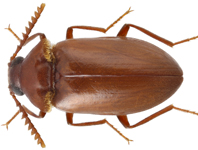Abstract
The Family Entomolepididae is composed by 7 genera and 15 species. During a survey on the known species and the search for new species, a new Spongiopsyllus is described associated with sponge Aplysina insularis. The new species has antennule 14-segmented, four setae on both lobes of maxillule, some unique features on the leg setation and the armature of the maxilliped. These characteristics make the new species different from all other congeners in Spongiopsyllus. The diagnosis of Entomopsyllus was also revised once it does not consider the differences to Spongiopsyllus which was created posteriorly to its erection. An analysis of Entomopsyllus stocki also indicated that leg 5 somite and the genital somite are fused, instead of separated as originally stated, the structure is also redescribed. Finally, Parmulodes verrucosus is studied and an up-to-date description is provided, correcting some inconsistencies in the armature formula of the antennule and the leg setation, and providing re-analysis of the other appendages.
References
Canário, R., Neves, E. & Johnsson, R. (2012) Spongiopsyllus redactus, a new species of Entomolepididae (Copepoda, Siphonostomatoida) associated with a scleractinian coral in Brazil. Zoosymposia, 8, 49–55.
https://doi.org/10.11646/zoosymposia.8.1.8
Eiselt, J. (1959) Entomolepis adriae, ein Beitrag zur Kenntnis der kaum bekannten Gattungen siphonostomer Cyclopoiden: Entomolepis, Lepeopsyllus und Parmulodes (Copepoda, Crust.) Sitzber. Österreichische Akademie der Wissenschaften, Mathematisch-Naturwissenschaftliche. Klasse, 168, 643–660.
Huys, R. & Boxshall, G.A. (1991) Copepod Evolution. The Ray Society, London, 468 pp.
Johnsson, R. (2000) Spongiopsyllus adventicius new species and genus of Entomolepididae (Copepoda: Siphonostomatoida) associated with sponges in Brazil. Hydrobiologia, 417, 115–119.
https://doi.org/10.1023/A:1003815707337
Johnsson, R. & Neves, E.G. (2012) Siphonostomatoid copepods (Crustacea) associated with marine invertebrates and algae in Brazil: a review and future considerations. Zoosymposia, 8, 69–80.
https://doi.org/10.11646/zoosymposia.8.1.10
Kim, I.H. (2004) Two new species of siphonostomatoid copepods (Crustacea) associated with the stoloniferan coral Tubipora musica (Linnaeus) from Madagascar. Korean Journal of Biological Sciences, 8, 187–196.
https://doi.org/10.1080/12265071.2004.9647750
Lee, J. & Kim, I.H. (2017) Siphonostomatoid copepods (Crustacea) associated with sponges from the Philippines and Vietnam. Animal Systematics, Evolution and Diversity, 33 (2), 73–99.
https://doi.org/10.5635/ASED.2017.33.2.007
Mckinnon, A.D. (1988) A revision of Entomolepididae (Copepoda: Siphonostomatoida) with Descriptions of Two New Species from Australia, and Comments on Entomolepis ovalis Brady. Australian Journals of Science Research, 2, 995–1012.
https://doi.org/10.1071/IT9880995
Spalding M.D., Fox, H.E., Allen, G.R., Davidson, N., Ferdaña, Z.A., Finlayson, M., Halpern, B.S., Jorge, M.A., Lombana, A., Lourie, S.A., Martin, K.D., McManus, E., Molnar, J., Recchia, C.A. & Robertson, J. (2007) Marine ecoregions of the world: a bioregionalization of coastal and shelf areas. BioScience, 57, 573–583.
https://doi.org/10.1641/b570707
Stock, J.H. (1992) Entomolepididae (Copepoda: Siphonostomatoida) from the Antilles. Studies on the Natural History of the Caribbean Region, 71, 53–68.
Thompson, I.C. & Scott, A. (1903) Report on the Copepoda collected by Prof. Herdman, at Ceylon, in 1902. Ceylon Pearl Oyster Fish. Gulf of Manaar, Supplementary Repports, 7, 227–307, pls. 1–20.
https://doi.org/10.5962/bhl.title.59334
Ummerkutty, A.N.P. (1960) Studies on Indian Copepods, 1. Paralepeopsyllus mannarensis, a new genus and species of cyclopoid copepod from the Gulf of Mannar. Journal of Marine biology Association of India, 2 (1), 105–114.
Uyeno, D. & Johnsson, R. (2018) Two new species of Siphonostomatoida (Copepoda) found on cnidarians in Tokara Islands, Southern Japan. Journal of Natural History, 52, 2639–2652.
https://doi.org/10.1080/00222933.2018.1541199
Wilson, C.B. (1944) Parasitic copepods in the United States National Museum. Proceedings of the United States National Museum, 94, 529–582.

